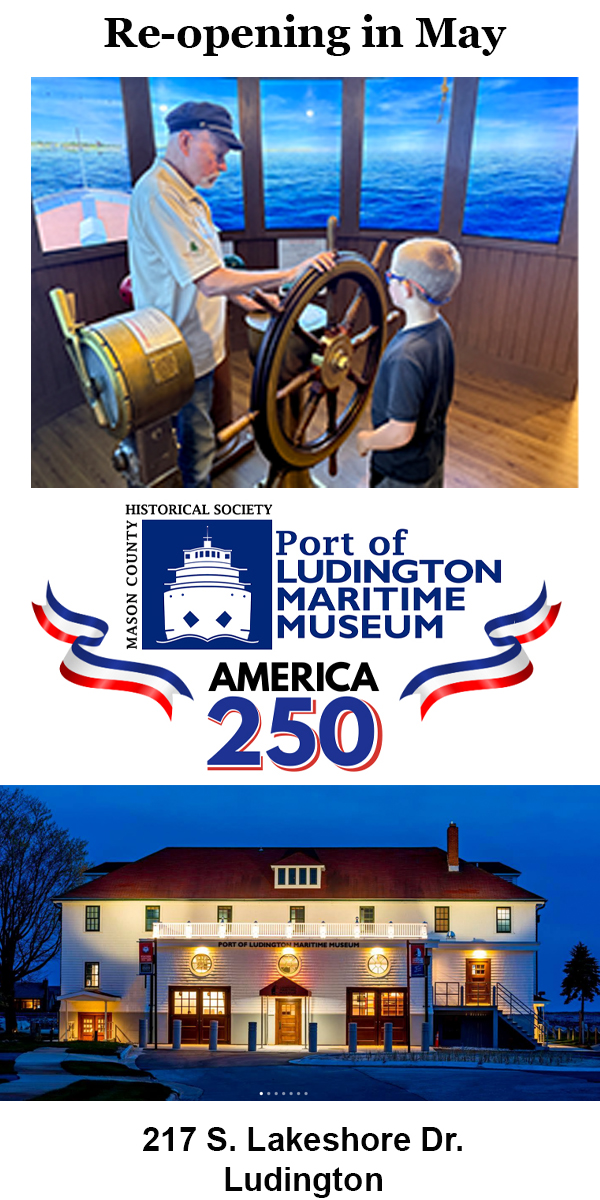
Loretta Harjes works on keeping the thousands of obituaries in order at the Oceana County Historical and Genealogical Society headquarters in Hart.
Passionately preserving history.
By Allison Scarbrough, Editor.
HART – Before you step inside the headquarters of the Oceana County Historical and Genealogical Society, you learn a history lesson by admiring its exterior.
The 127-year-old building at 114 Dryden St. is made of local fieldstone that was hand-blocked. The distinctive rectangle stones offer a unique design since most stone houses in the late 1800s had round stones. The stone was quarried in Hart, and every stone was cut to size.
Note the Grecian portico gracing the entrance, the castle-style turret and the arched upstairs windows.
The Chadwick-Munger Building was constructed in 1892 by Dr. HJ Chadwick. When Chadwick moved to Grand Rapids to work as a surgeon, another doctor took over — Dr. LP Munger, said OCHGS President Walter Urick. Munger lived in the stately home from 1897 to 1958, and he conducted his medical practice in that house. Munger was also the largest cherry grower in the area. His original office chair remains in the building.
The historical structure once housed the health department in Oceana County and also served as the Church of the Nazarene, Walt said.
In 1984, the historical society took over ownership of the Chadwick-Munger Building and renovated it to serve as a historical archive for decades to come.
Along with the headquarters in Hart, the society maintains the Oceana Historical Park and Museum in Mears.
The historical society, which formed in 1967, is a non-profit organization, depending solely on volunteer efforts. Approximately 50 volunteers are involved in board activities, maintenance, museum functions at the Mears complex, or in organizing records, photos, artifacts and many other historical items.
In addition to Walt Urick, the board consists of Vice President John Varenhorst, Recording Secretary Barbara Sheren, Corresponding Secretary Loretta Harjes, Treasurer Dennis Gale, Past President Karen Urick, Board Members Betty Driscoll, Paul Erickson, Mary Jane Morat, Carmine Osborne, David Rakosky, Joan Ryan, George Sadler, Pat Tate and Carl Wiegand.
The organization operates through donations and membership dues, said Karen Urick. “We are busy, but we have a good time,” she said.
In 1978, the historical society added obituaries to its long list of preserved documents. Ultimately in 1997, the organization added the genealogical component to its role and name. “We have thousands of obits dating back to the 1840s thanks to donations of newspapers and scrap books,” said Karen.
In 1990, OCHGS published a book about Oceana’s history and then followed with two more volumes that were published in 1992 and 2005. Those and other books are for sale at the headquarters. Visit www.oceanahistory.org for more information about the books and the society itself.
The Chadwick-Munger Building is open for tours on Wednesdays from 10 a.m. to 5 p.m. It is also an opportunity to do some research in the vast amount of files that the society offers.
 OCHGS welcomes more historical items to add to its impressive collection. “We are always looking for scrapbooks, post cards, pictures, school records, etc. to add to the collection,” said historical society volunteer Marge Peterson. The organization welcomes new volunteers as well.
OCHGS welcomes more historical items to add to its impressive collection. “We are always looking for scrapbooks, post cards, pictures, school records, etc. to add to the collection,” said historical society volunteer Marge Peterson. The organization welcomes new volunteers as well.
While touring the historical building, you will discover that at one time there were 101 rural schools in Oceana County. The Chadwick-Munger Building has a room completely dedicated to local school history with school records dating back to the early 1900s and a huge collection of yearbooks or annuals as they were called back in the day.
In the front part of the building, you will see paintings of the famous Little Sable Point Lighthouse in Silver Lake. The iconic structure was painted white in 1900 so it could be more easily seen by mariners. In 1975, it was sandblasted and returned to its natural brick color.
You can research information about the Three Sisters, which are three large hills located along the Lake Michigan shoreline in Pentwater, that guided sailors back to shore in stormy waters.
There is an entire history of the William Field Memorial Hart-Montague Bicycle Trail. When the late William Field first proposed converting the old railroad tracks into a bicycle trail, he was met with strong opposition and even mocked for his innovative idea. It was one of the first “Rails to Trails” projects in the state, and its success paved the way for more trails throughout Michigan and the Midwest.
The society has an entire room dedicated to Native American history. There were 17 Indian chiefs who came to Oceana County, said Karen Urick, including Chief Cobmoosa. Josette DeRouier was one of the most well known Native Americans who lived in Oceana County, and she was a midwife to Dr. Munger.
If you are researching agricultural or lumbering history, take a look at the vast collection of documents and photos stored in the Chadwick-Munger Building. After the Great Chicago Fire, the shoreline was dotted with stumps. Lumberjacks cut down the trees to rebuild Chicago, and farmers here grew their crops in between the tree stumps, making the landscape look much less barren.
“The Civil War soldiers came here, because they got land for their pay,” said Karen. Although there are no Indians that are native to Oceana County, many came here after the area was settled, she said. “Each Indian was allowed a certain amount of property.”
 “Our earliest records go back to 1850,” she said. “Before that, the records were in Kent County.”
“Our earliest records go back to 1850,” she said. “Before that, the records were in Kent County.”
“Everything has been donated. When people are downsizing, they need to think about the historical society. We take anything that is non-perishable and associated with Oceana County,” said Marge.
There have been stories about how Oceana County got its name, but none are confirmed, Karen said. There is the theory that when settlers arrived, they were so impressed by the vastness of Lake Michigan and compared it to an ocean – hence Oceana.
Claybanks Township got its name from the banks along the lakeshore being all clay, she said.

View of Hart looking south before the Hart Dam and Hart Lake existed. The photo was taken no later than 1890.
Old newspaper articles are archived on microfilm and digitally. The oldest newspaper in Oceana County is the Pentwater News in 1861. “There is an enormous amount of information about the Civil War,” Karen said.
There are volumes of photos of headstones in the county’s 44 cemeteries.
“Our master index surpassed the 900,000 mark yesterday,” said Board Member Betty Driscoll, “with over 7,000 extra on our way to one million.”
 Upstairs, there are 23,000 historical photos on file. Those interested in donating either historical or modern photos, can have their pictures digitally scanned at the headquarters so they don’t have to give them away. There are thousands of post cards on file too. Everything is documented and has a inventory number.
Upstairs, there are 23,000 historical photos on file. Those interested in donating either historical or modern photos, can have their pictures digitally scanned at the headquarters so they don’t have to give them away. There are thousands of post cards on file too. Everything is documented and has a inventory number.
“When someone comes in here trying to find their genealogy, their eyes just light up when they find their ancestors,” said Marge.
The Oceana County Historical and Genealogical Society has been deemed one of the best organizations of its kind, and it is due not only to the rich history it preserves but the many dedicated volunteers who work tirelessly to preserve it.
This story is copyrighted © 2019, all rights reserved by Media Group 31, LLC, PO Box 21, Scottville, MI 49454. No portion of this story or images may be reproduced in any way, including print or broadcast, without expressed written consent.


















































.png)



